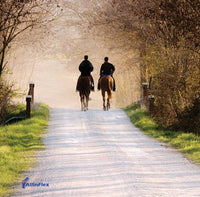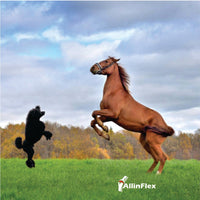Equestrian Disciplines in New Zealand
Equestrian pursuits in New Zealand have a storied history, reflecting not only the country's agricultural traditions but also a deep-seated passion for the grace, power, and agility of the horse.
From the thrill of the racetrack to the finesse of dressage, equestrian disciplines have captivated Kiwis for generations, and this national enthusiasm shows no sign of waning.
Today, New Zealand is recognised globally in various equestrian disciplines, boasting successful riders on the international stage, including the Olympics and World Championships.
New Zealand's association with equestrian sports has deep historical roots, harking back to a time when the horse was central to farming, transportation, and leisure.
The late 19th and early 20th centuries marked the dawn of horse racing in New Zealand, with the New Zealand Cup, inaugurated in 1865, rapidly emerging as one of the country's most highly awaited sporting occasions.
As the 20th century rolled on, show jumping and eventing made their debut, aided by local shows offering them a much-needed platform. Dressage too found its place in the spotlight, but only towards the latter part of the 20th century.
Equestrian disciplines serve an important economic function in New Zealand.
Horse racing, in particular, contributes significantly to the economy, fostering job creation and boosting tourism. In addition, the ethos of equestrianism promotes respect for animal welfare and environmental conservation, considering the paramount importance of horse care and the maintenance of quality competition venues.
Internationally, New Zealand's equestrian achievements has not gone unnoticed, with several athletes achieving recognition on the global stage.
A notable mention is Sir Mark Todd, whose glittering career in eventing includes an impressive tally of international victories and Olympic medals. Blyth Tait, Andrew Nickelson, Tim and his wife Jonelle Price, Caroline Powell and Vaughn Jefferies are other famous names in eventing.
Show jumping has seen the likes of Katie Laurie, John Cottle and Daniel Meech represent New Zealand with distinction.
The dressage world has been graced by Sharon and Kallista Field, Melissa Galloway, Louisa Hill, Julie Brougham, John Thompson, Gaylene Lennard whose performances have drawn international attention.
Not forgetting the realm of horse racing, which has produced accomplished jockeys such as Michael Walker and James McDonald.
Ultimately, equestrianism in New Zealand extends far beyond the sporting realm.
It is deeply ingrained in the country's cultural fabric, a testament to its agricultural heritage, a reflection of its adventurous spirit, and a significant contributor to its national identity.
Often referred to as the ballet of equestrian sports, dressage is a discipline that showcases a horse's flexibility, balance, and obedience.
Dressage is unique in its ability to demonstrate the intense training and connection between horse and rider, as they perform a series of predetermined movements known as a 'test'.
Dressage competitions in New Zealand range from novice to Grand Prix level, accommodating riders of varying skills and experience and Dressage NZ is the discipline's governing body.
Today, dressage holds an essential place in New Zealand's equestrian sphere and is the basic of all the other disciplines.
Its increasing popularity and participation rates are testament to the dedication and passion of the country's equestrian community.

Show jumping is an exhilarating equestrian discipline that truly tests the agility, speed, and precision of both horse and rider.
This sport involves navigating a course of jumps within a set time, with the aim to clear all the obstacles without any faults. It is a true spectacle of skill and courage that captivates audiences worldwide, and New Zealand is no exception.
One of the key highlights of the show jumping calendar in New Zealand is the annual Horse of the Year show held in Hastings.
This event, known for attracting top riders from around the country, offers an exciting platform for competitors to showcase their talent in various classes, from Pony Grand Prix to the Olympic Cup.
Equestrian Sports New Zealand (ESNZ) oversees show jumping in the country and is responsible for hosting the National Show Jumping and Show Hunter Championships. Both of these events are hotly contested and celebrate the best of New Zealand's show jumping talent.
Eventing, often described as the triathlon of the equestrian world, is a multifaceted discipline that demands versatility and stamina from both horse and rider.
This sport, with its roots embedded in military training, combines three distinct phases: dressage, cross-country, and show jumping.
Each phase tests different aspects of the horse-rider partnership, and it is the overall performance across these phases that determines the winner.
The first phase of eventing, dressage, requires the horse and rider to perform a set of pre-determined movements in an arena.
This phase highlights the pair's harmony, precision, and the horse's obedience. The scoring is similar to that of a standalone dressage competition, with judges awarding marks for each movement and overall presentation.
The second phase, cross-country, tests the pair's courage, speed, and endurance. Over a course that spans several kilometres, the horse and rider navigate a series of fixed natural and artificial obstacles, including water jumps, ditches, and banks.
This phase is timed, with penalties incurred for refusals, falls, and exceeding the optimum time.
The final phase, show jumping, serves as a test of the horse's agility and the rider's accuracy.
Taking place in an arena, this phase involves clearing a series of jumps without knocking any poles down or refusing any jumps. Penalties are given for any faults, with the aim to complete the course in the quickest time with the fewest faults.
Together, these phases present a comprehensive test of all-round equestrian ability. The complexity and diversity of eventing make it a challenging yet rewarding discipline, widely respected within New Zealand's equestrian community and beyond.
Endurance riding is an equestrian discipline that puts stamina and horsemanship to the ultimate test.
It involves covering long distances, typically ranging from 25 to 160 kilometres, within a specified maximum time. The sport's primary aim is to prove the speed and endurance of a horse while ensuring its optimum health and well-being throughout the event.
Preparing for endurance events is an extensive process that requires considerable training, planning, and care for both horse and rider.
Key elements of preparation include learning to read the horse's vital signs, such as heart rate and respiration rate, and understanding the impact of various factors like terrain, weather, and pacing on the horse's performance.
Attention to nutrition, hydration, and rest is also critical, as is the ability to respond to any health issues that may arise during the ride.
Endurance New Zealand is the organisation responsible for overseeing endurance riding in the country. There are numerous endurance riding events throughout the year, catering to different levels of experience, from introductory rides to more challenging long-distance rides.

Horse racing in New Zealand enjoys a storied history that dates back to the 19th century.
As one of the earliest organised forms of equestrian competition in the country, it holds a special place in New Zealand's sporting and cultural heritage.
This thrilling sport involves thoroughbred horses racing over a set distance, with significant betting activities adding an extra layer of excitement to the event.
The significance of horse racing in New Zealand extends beyond the excitement of race day. The racing industry is a vital component of the economy, generating revenue, employment, and contributing to tourism.
It is also tightly woven into the social fabric, with race meetings traditionally being a focal point for community gatherings and celebrations.
The rodeo is an exciting equestrian discipline that originates from the working practices of cattle herding in Spain and Mexico, later adapted in the United States, and eventually spread globally, including New Zealand.
Rodeo involves a series of competitive events that test the skill and speed of cowboys and cowgirls in activities closely tied to ranching traditions.
The history of rodeo in New Zealand stretches back to the early 20th century, where it found its roots in the rural traditions and practices of the farming communities.
Over time, rodeo has grown into a well-structured and popular spectator sport, with competitions taking place throughout the summer at various rodeo grounds around the country.
Rodeo events are wide-ranging, each with its own set of rules and scoring systems. Some of the classic rodeo events include bull riding, bareback and saddle bronc riding, steer wrestling, team roping, barrel racing, and calf roping. Each of these events presents a unique challenge that requires strength, agility, courage, and a deep understanding of livestock.
The New Zealand Rodeo Cowboys Association (NZRCA) oversees rodeos in New Zealand, ensuring safety standards for both participants and animals.
Polo, often termed as 'the sport of kings', is an equestrian team sport renowned for its speed, skill, and the level of coordination required between the horse and rider.
The game involves two teams of four riders each, aiming to drive a small white ball into the opponent's goal using a long-handled mallet, all whilst galloping at full speed.
Introduced to New Zealand in the late 19th century, polo quickly gained traction among the country's elite, establishing a place in New Zealand's sporting fabric.
Over the years, it has evolved from being a sport primarily associated with the aristocracy to being enjoyed by a wider spectrum of equestrian enthusiasts. It is now played at both amateur and professional levels, with numerous clubs and tournaments active throughout the country.
Polo clubs form the heart of the sport in New Zealand, fostering talent, hosting matches and tournaments, and offering training for both players and ponies.
Carriage driving, also known as competitive driving, is a form of equestrian sport that involves driving a horse or a team of horses pulling a carriage.
While it harks back to the days when horses were a primary mode of transportation, in the modern context, it is a competitive discipline that tests the driver's skill, precision, and control over the horses.
Carriage driving competitions are typically divided into three phases: dressage, marathon, and cones. Dressage requires the horse and driver to execute a series of compulsory figures within a marked arena, demonstrating obedience, flexibility, and balance.
The marathon phase involves covering a long-distance course with multiple obstacles, testing the horse's stamina and the driver's navigation skills. The cones phase involves driving through a precise course marked by cones with balls balanced on top, with penalties for any balls dislodged.
Rules and regulations for carriage driving are overseen by the Fédération Équestre Internationale (FEI) at the international level and by Equestrian Sports New Zealand at the national level. These rules cover a range of areas, including equipment, animal welfare, competition format, scoring, and driver conduct.
Equestrian vaulting, or simply 'vaulting', is a distinctive and dynamic discipline that combines elements of gymnastics and dance performed on the back of a moving horse.
It is a sport that requires strength, flexibility, balance, and an exceptional degree of harmony with the horse.
The origins of vaulting can be traced back to ancient Roman games, but it was in post-war Germany where the sport was developed into its modern competitive form.
Vaulting was introduced to New Zealand in the late 20th century and has since grown in popularity, becoming a recognised discipline under Equestrian Sports New Zealand.
Training for vaulting involves both gymnastic preparation and work with the horse.
Vaulters must develop strength, flexibility, and balance through off-horse training, which often includes dance, acrobatics, and strength conditioning.
On-horse training is equally crucial and involves learning to move in harmony with the horse, developing the timing, coordination, and courage necessary to execute movements at a canter.
Equestrian Sports New Zealand, the governing body for equestrian disciplines in the country, oversees vaulting events and provides resources for those interested in participating or advancing in the sport.
The Future of Equestrian Sports in New Zealand
Equestrian sports in New Zealand are poised for an exciting future, with growing participation at the grassroots level and continued success on the international stage. Efforts to improve access to the sport and to diversify its participant base are expected to stimulate further growth.
Furthermore, initiatives to increase the visibility of equestrian sports, such as enhanced media coverage and community outreach programmes, will likely help to attract new audiences and participants.
Technology is increasingly playing a pivotal role in equestrian sports, from biomechanics analysis aiding rider and horse performance, to the use of digital platforms for event promotion and fan engagement.
Wearable technologies for horses, including health and fitness tracking devices, are expected to become more commonplace, helping riders, trainers, and vets monitor and optimise horse welfare and performance.
Equestrian sports contribute significantly to the New Zealand economy, supporting jobs in areas such as horse breeding, training, event organisation, and equine health services.
Furthermore, high-profile equestrian events attract tourists and stimulate local economies, a trend that is expected to continue as the popularity of these events grows.
In the future, there is potential for increased international equestrian tourism, with visitors drawn to New Zealand’s stunning riding locations and high-quality equestrian events.
Whether you're an avid equestrian, an enthusiastic spectator, or just curious about the world of horses, New Zealand's equestrian disciplines offer a multitude of ways to engage.
So why not visit a local event, take a riding lesson, or even just watch an equestrian competition on TV? As you delve deeper, you'll discover a sport that is not only exciting and diverse, but also anchored in a profound respect for the remarkable partnership between horse and human. It's a journey well worth taking.



